#informative vector post
Explore tagged Tumblr posts
Text




Vector makes his coworkers do all the work.
#vector the crocodile#sth#team chaotix#informative vector post#informative chaotix post#been a little bit#i got some other nefarious activities to do... like drawing#i still got a billion things to post... the problem is organizing it all#SOON#i think i have even more examples of vector doing this tbh#probably can count TSR a bit#vector is a fraud.....#screenshots#mario & sonic olympic games#mario & sonic at the winter olympic games#shth 2005#sonic channel
50 notes
·
View notes
Text
So like, transandrophobia.
To start this out, I am a trans woman, been around in the queer community for a while. I'm also bisexuality, polyamorous, disabled, and aromantic, and I think these other parts of my identity and the crap I've caught over the years for them heavily informs how I analyze something like transandrophobia. My wife is also asexual, so that plays a part in it too.
So every group of marginalized people has their own unique experiences and problems. It's more of a rule than something we've mathematically demonstrated, but as far as these things go it's ridiculously well established, and personally every time I've done even a basic dive into the issues faced by a marginalized group it's been self evident. I could easily list a dozen groups ranging from racial minorities to different kinds of disabled people to different queer identities and analyze their social issues but let's be real, this is pretty well established theory, anyone who needs me to do that is not really interacting with good faith. This is one of the big reasons we talk to people about their own experiences and groups, we cannot reasonably extrapolate the experiences of others from our own.
So like trans men and trans mascs and anyone else that falls under that umbrella has their unique experiences. The idea that we would even question this is weird to me? Like I can't even imagine the kind of evidence someone would need to present to me to change my mind, and given the pattern of the queer community to be shitty in exactly this way to people in our community, yeah that is not happening.
Therefore, we are taking it for granted that the trans men/masc/related umbrella has their own things going on like everyone else ever, and I don't understand how someone acting in good faith can try to claim otherwise unless they are young or otherwise very inexperienced with such things.
The next point of contention seems to be the name, and I gotta be real I don't care and I don't understand why other people do. I've read all sorts of arguments against the word transandrophobia and the majority of them seem to be rooted in a misunderstanding of intersectionality, and even then it's like there is such a thing where people get so mired in theory that they miss the forest for the trees.
Perhaps more important to me, getting overly worked up about something as unimportant as the precise term is... weird. Like exclusionists hating on bi and ace people weird. I remember what it was like a decade ago when exclusionists were trying to police the words of bi women, and five years ago when ace and aro people were under constant attack under the pretense that our language was harmful for some reason or other. You are going to have to work very, very, very hard to convince me that any bickering over language as it relates to transandrophobia is not just more of the same.
Next, "transandrobros hate trans femmes" and similar stuff. I've seen the callout posts and found them completely unconvincing. Again, they read a lot like the old "ace people hate lesbians!" posts I used to see. I'm not convinced that the individuals involved were a problem, I am certainly not able to extrapolate a problem to the rest of the group.
Finally, there is this idea that "maleness is not a vector for oppression" and this invalidates something about the whole transandrophobia thing, ranging from the entire concept of trans men experiencing prejudice to something about language being imprecise all the way to "This is fascist shit, omg these people are basically nazis" depending on who says it. I'm not going to touch any of that and just look at the underlying logic.
This is based off a misunderstanding of intersectionality theory. Many people think of intersectionality as defining intersecting prejudice, like a ven diagram, such that transmisogyny is the intersection of transphobia and misogyny. This is incorrect. Intersectionality defines unique prejudice experienced by people with intersecting identities. Instead of a transmisogyny as the overlap of transphobia and misogyny, imagine adding a third circle that overlaps both but also has its own areas covered by neither.
Applied to transandrophobia, even if we assume maleness is not a vector for oppression, there is no reason to assume that the intersection of maleness with a marginalized identity doesn't result in new issues. Imagine that 3 circle venn diagram that represents misogyny, transphobia, and transmisogyny. Even if you remove the misogyny circle there is still plenty of ground covered by the transmisogyny circle.
This just isn't a valid criticism. It is a pure theory approach based on a flawed reading of theory.
So in summary:
Everyone has their unique shit going on and I've seen no convincing evidence that trans men, mascs, etc. Are the exception.
I not seen any convincing argument that the word itself is bad.
I've not seen any convincing evidence that there is some epidemic of transandrophobia truthers hating and harassing trans femmes on scales higher than normal background queer infighting.
The most coherent objection to transandrophobia I've seen is categorically incorrect and based on a fundamental misunderstanding of intersectionality theory.
I would like to remind everyone at this point I am a trans woman, part of the group that is supposedly a problem for and I've just not see it at all, to the point where it is kind of weird how intensely some people are pushing this.
I'm not trying to be mean or whatever, I'm sure the distress on display here comes from a real place and real trauma, but I've yet to see anything that makes me think there is substance to the objections to transandrophobia as a concept. It feels and reads like the latest round of queer intracommunity exclusionism, and the fact that this time around I'm not one of the target identities doesn't change that for me.
#I was tired of this shit 8 years ago when lesbians were telling me I was evil for calling myself a bisexual femme#You are going to have to do a lot better than this to convince me that trans dudes using a word is some crisis
2K notes
·
View notes
Text
PLEASE JUST LET ME EXPLAIN REDUX
AI {STILL} ISN'T AN AUTOMATIC COLLAGE MACHINE
I'm not judging anyone for thinking so. The reality is difficult to explain and requires a cursory understanding of complex mathematical concepts - but there's still no plagiarism involved. Find the original thread on twitter here; https://x.com/reachartwork/status/1809333885056217532
A longpost!

This is a reimagining of the legendary "Please Just Let Me Explain Pt 1" - much like Marvel, I can do nothing but regurgitate my own ideas.
You can read that thread, which covers slightly different ground and is much wordier, here; https://x.com/reachartwork/status/1564878372185989120
This longpost will; Give you an approximately ELI13 level understanding of how it works Provide mostly appropriate side reading for people who want to learn Look like a corporate presentation
This longpost won't; Debate the ethics of image scraping Valorize NFTs or Cryptocurrency, which are the devil Suck your dick
WHERE DID THIS ALL COME FROM?
The very short, very pithy version of *modern multimodal AI* (that means AI that can turn text into images - multimodal means basically "it can operate on more than one -type- of information") is that we ran an image captioner in reverse.


The process of creating a "model" (the term for the AI's ""brain"", the mathematical representation where the information lives, it's not sentient though!) is necessarily destructive - information about original pictures is not preserved through the training process.


The following is a more in-depth explanation of how exactly the training process works. The entire thing operates off of turning all the images put in it into mush! There's nothing left for it to "memorize". Even if you started with the exact same noise pattern you'd get different results.

SO IF IT'S NOT MEMORIZING, WHAT IS IT DOING?
Great question! It's constructing something called "latent space", which is an internal representation of every concept you can think of and many you can't, and how they all connect to each other both conceptually and visually.

CAN'T IT ONLY MAKE THINGS IT'S SEEN?
Actually, only being able to make things it's seen is sign of a really bad AI! The desired end-goal is a model capable of producing "novel information" (novel meaning "new").
Let's talk about monkey butts and cigarettes again.

BUT I SAW IT DUPLICATE THE MONA LISA!
This is called overfitting, and like I said in the last slide, this is a sign of a bad, poorly trained AI, or one with *too little* data. You especially don't want overfitting in a production model!
To quote myself - "basically there are so so so many versions of the mona lisa/starry night/girl with the pearl earring in the dataset that they didn't deduplicate (intentionally or not) that it goes "too far" in that direction when you try to "drive there" in the latent vector and gets stranded."
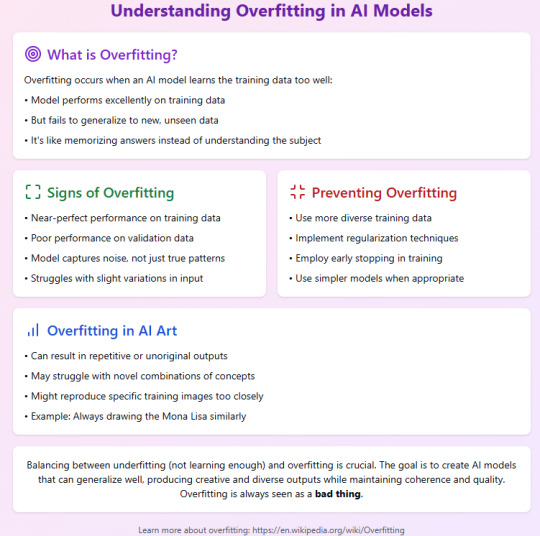
Anyway, like I said, this is not a technical overview but a primer for people who are concerned about the AI "cutting and pasting bits of other people's artworks". All the information about how it trains is public knowledge, and it definitely Doesn't Do That.
There are probably some minor inaccuracies and oversimplifications in this thread for the purpose of explaining to people with no background in math, coding, or machine learning. But, generally, I've tried to keep it digestible. I'm now going to eat lunch.
Post Script: This is not a discussion about capitalists using AI to steal your job. You won't find me disagreeing that doing so is evil and to be avoided. I think corporate HQs worldwide should spontaneously be filled with dangerous animals.
Cheers!
1K notes
·
View notes
Text

I'm so sorry Sonic fandom but this is about the little cunt from Yugioh Zexal

Your guy looks like this

Well anyway, here it is
Vector's VA being silly in the booth
164 notes
·
View notes
Text

if you want to reblog this post, please make sure it is with the addition clarifying more accurate information about OCD
idk if this is just me but rabies is exactly like if something was made up specifically to fuck with people with OCD. you're telling me there's a disease endemic to large portions of the world that can live in my body with no symptoms for years? once symptoms start it is 100% You Die Disease? and one of its major vectors where i live is an extremely common animal with teeth so small it's possible not to even notice it bit you? surely i can get vaccinated though--ah, no, you need a "reason" or they don't give you the shot. the standard of prevention is Vigilance, Checking, and Avoiding Certain Behaviors, things that my brain is very good at doing in a healthy way, for sure. eat my ass.
1K notes
·
View notes
Text
The Best News of Last Week - 29 April 2024
1. Net neutrality rules restored by US agency
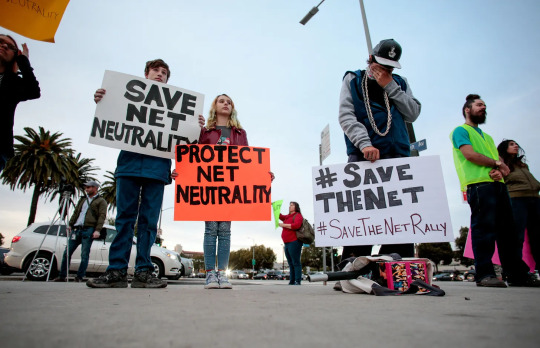
The U.S. Federal Communications Commission voted 3-2 on Thursday to reinstate landmark net neutrality rules and reassume regulatory oversight of broadband internet rescinded under former President Donald Trump.
2. Airlines required to refund passengers for canceled, delayed flights

DOT will also require airlines to give cash refunds if your bags are lost and not delivered within 12 hours.
The refunds must be issued within seven days, according to the new DOT rules, and must be in cash unless the passenger chooses another form of compensation. Airlines can no longer issue refunds in forms of vouchers or credits when consumers are entitled to receive cash.
3. How new mosquito nets averted 13 million malaria cases

Compared to standard nets, the introduction of 56 million state-of-the-art mosquito nets in 17 countries across sub-Saharan Africa averted an estimated 13 million malaria cases and 24,600 deaths. The New Nets Project, an initiative funded by Unitaid and the Global Fund and led by the Innovative Vector Control Consortium (IVCC), piloted the use of dual-insecticide nets in malaria-endemic countries between 2019 and 2022 to address the growing threat of insecticide resistance.
4. Germany has installed over 400,000 ‘solar balconies’

This new wave of solar producers aren’t just getting cheap electricity, they’re also participating in the energy transition.
More than 400,000 plug-in solar systems have been installed in Germany, most of them taking up a seamless spot on people’s balconies.
5. Voyager-1 sends readable data again from deep space
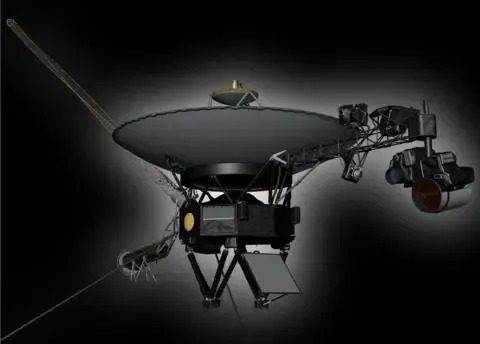
The US space agency says its Voyager-1 probe is once again sending usable information back to Earth after months of spouting gibberish.
The 46-year-old Nasa spacecraft is humanity's most distant object.
6. Missing cat found after 5 years makes 2,000-km journey home
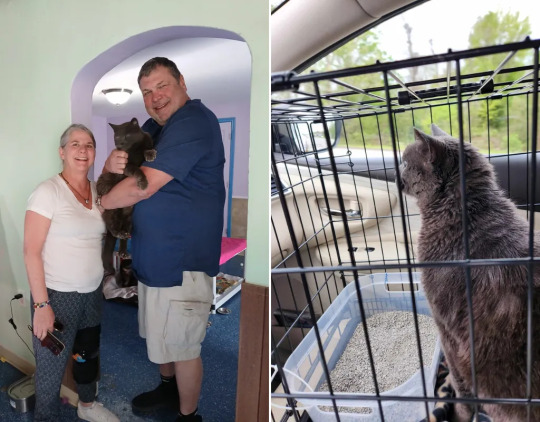
Five years after it ran out the door, a lost cat was returned to a couple in Nevada after it was found thousands of kilometres away. The couple are praising the cat’s microchip for helping reunite them.
7. Restoring sight is possible now with optogenetics
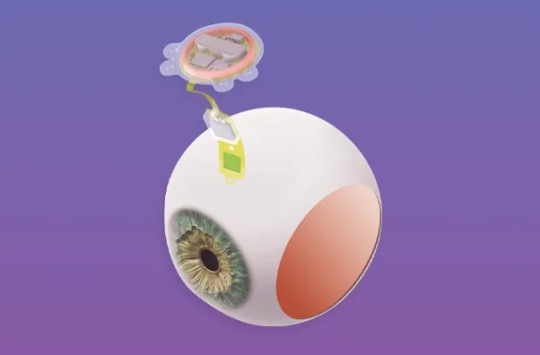
Max Hodak's startup, Science, is developing gene therapy solutions to restore vision for individuals with macular degeneration and similar conditions. The Science Eye utilizes optogenetics, injecting opsins into the eye to enhance light sensitivity in retinal cells.
Clinical trials and advancements in optogenetics are showing promising results, with the potential to significantly improve vision for those affected by retinal diseases.
---
That's it for this week :)
This newsletter will always be free. If you liked this post you can support me with a small kofi donation here:
Buy me a coffee ❤️
Also don’t forget to reblog this post with your friends.
653 notes
·
View notes
Text
Dirges in The Dark by WixWrites
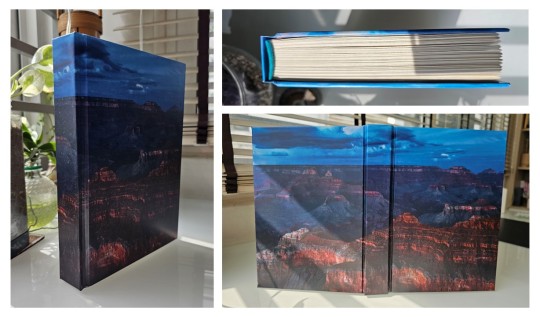
Before I start, let me just say: Ranchers! Scarian! Hermits and Life Series and Empires characters! Sheriff Jimmy! Sheriff Scar! Criminal Tango! the Wild West! Treebark and Ethubs!
RANCHERS. THE WILD WEST. CREEPING ELDRITCH HORROR.
Whoo, that was a rush.
I'll be honest; I think this book would have come out much sooner if not for my decision to add-in a whole lot of stuff into the text and pages. It got to the point that the original cover would have been a wanted poster at the front and a sheriff's report at the back!
I had to restrain myself, lest this book would never get finished at all. It's already been 59 days since my last post, and doing the original cover would have stretched the days even further. So I had to follow the mantra: Finished, not perfect. Besides, nothing says I can't make another version in the future...


From the moment I finished this fic, I knew it would become a book. But at 143,412 words, Dirges in The Dark by @twodiamondhoes would stretch my ficbinding skills to the limit and would be the second-ever bind that would reach past 250 pages (the first was an MCYT Sleepy Bois fic that predates this blog that I want to redo).
Eventually, the full typeset took up 520 pages! And as such, I finally decided to use extra support for the entire textblock. From an old pair of pajamas, I backed strips of fabric with glue and paper before cutting it into tapes, forming a crucial support for the various weaves along the spine. I then covered the entire spine in brown wrapping paper for even more strength.




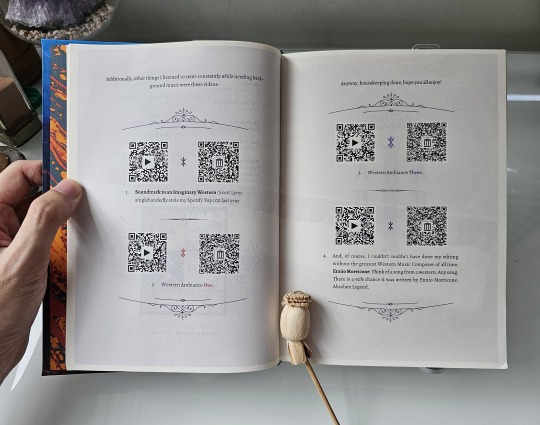
For the title and headings, I scoured for and found several typefaces, dingbats, and vector graphics which really evoked the fic's Western and Gothic vibes. I also took some inspiration from fellow ficbinders in the Renegade Publishing group for the style of layout and formatting throughout the book, such as using faded images in the background of these pre-story pages.
I wanted the reader to be immersed in the Wild West from the get-go, so having such images from the start — before the story even begins — felt very appropriate. I tried to make them thematic to the information presented, like a singing cowboy for the music playlist pages, but I think I made the image too faint to be seen!
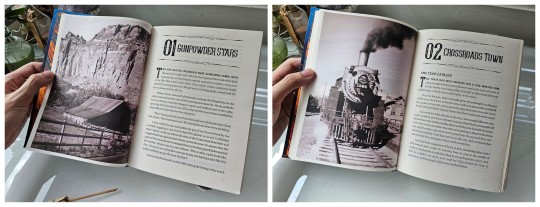
As for the chapter openers, I experimented with some layouts before finalizing on what you see: photos taking up one entire page on the left with the chapter titles and opening paragraphs on the right.
Just like my last bind, I want to make the reader feel immersed in the story and also bring out the mood of that particular chapter. This, however, led me to entire days of scouting and scouring stock photo sites just to find the right pictures for 11 different chapters. 4/10 would not recommend for sanity.

Given that the story uses a number of foreign words, old slang, and specific Wild West-era terms, I added a plethora of footnotes at the bottom of some pages for extra context and meaning.
I also wanted to be playful and make certain story parts, such as characters receiving letters and notes, really look like they're a part of the story. So I cropped old paper textures and fished out old fonts from the past to make them look as if they're actually there, pasted against the paragraphs!
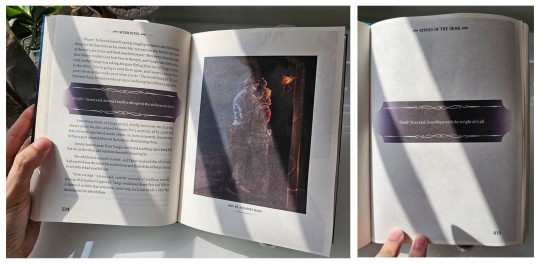
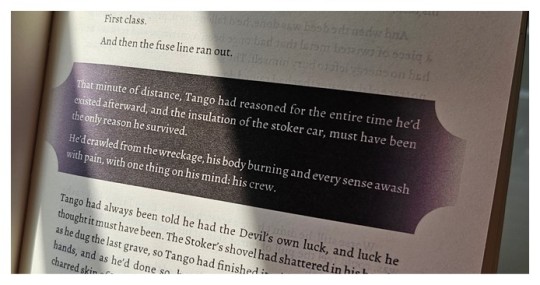
More importantly, there were some specific parts of the fic that felt super important and I wanted to highlight these passages, especially the Deals made by the characters throughout their arcs. Given DiTD has a certain affinity with eldritch darkness, I decided to highlight such paragraphs by backlighting them against a band of pure black. Besides being thematic as hell, I made the bands have curved edges and decorative lines to add a certain western-gothic touch!
It was from this that I begin to think "what if I can color entire pages to convey the mood and setting?"


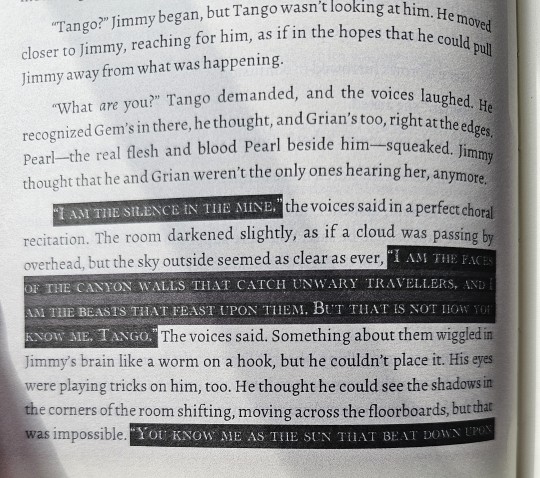
...Which led to the madness in these pages. I can't reveal too much because of spoilers, but there are certain times when the characters end up in situations where the very light turns to dark. Or they end up in hellish situations. Or the eldritch creatures began to speak.
It took some creative brainstorming to figure out how to show the mood of such scenes in printed pages, but I eventually figured out that I need find the right fonts, change their colors from black to white, and then change their backgrounds from white to dark to highlight them all! The power of formatting!
There's a lot more pages where I went wild with such shades and fonts, but I ain't revealing in public because spoilers!
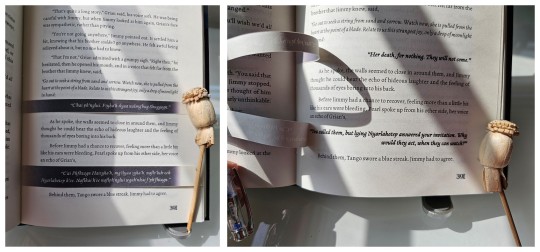
But undoubtedly, this is the biggest experiment I have made with this bind. There is a certain part where Grian and Pearl spoke in eldritch R'lyehian / Cthuvian, and I want to convey the sheer strangeness of the speech and it's meaning. Something outside the box.
Luckily, I have an inspiration in fellow fanbinder @mythrilthread, who made an amazing fanbind that used vellum overlays to showcase the speaking of alien languages and what they mean in English. AND IT LOOKS SICK AS FUCK. When I finished reading Dirges, I knew I had to emulate this form of language translation, so I printed the eldritch speech, cut it, and pasted it onto the spine to give a similar effect of strangeness, and IT LOOKS SO COOL!!!
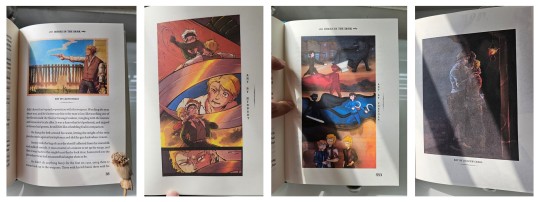
And lastly, I just had to include some of the amazing fanart made by readers into the book! All of these are placed by their corresponding text and chapters, and they all look so cool!
So I want to give a special thanks to @azzayofchaos, @leafdoodles, @hybbart, and @foxyola for granting their permission for me to include their incredible works into this bind! The dark shades and page formatting is one thing, but these works truly make this book feel so much more alive!
All in all, this bind was an odyssey in the making. I experimented with page formatting, layout wizardry, and bookmaking methods that I haven't tried before. While I know I could do better, I am beyond happy to see this work finished!
And once again, a thousand thanks to @twodiamondhoes / WixWrites for crafting an amazing story!

#bookbinding#fanbinding#ficbinding#my bookbinds#mcyt#Hermitcraft#Life SMP Series#Trafficblr#Empires SMP#Dirges In The Dark#jimmy solidarity#tangotek#team rancher#solidaritek#Wild West#Old West#American West
191 notes
·
View notes
Text
Also preserved in our archive
by: Beck Levy
“Maybe now vocalists will finally start bringing their own mics,” I tweeted in the first days of March 2020. My virtual audience was mostly friends I met by participating in subcultures in and adjacent to the DIY tendency of hardcore punk rock. In those early days, we on the cultural fringes shared a sense that the pandemic, in its capacity as a social intervention, could meaningfully disrupt the oppressive ruling order.
When I booked and played shows before COVID-19 hit, I tried to harness energy and rally when crisis arose. Touring band is lost on the road? I was ready to DJ to keep people from leaving between sets. No one came to unlock the club? Let’s play in the parking lot. The last show I’d played, just weeks earlier during Mardi Gras, was on a trailer being pulled by a dump truck. We’re responsive to shifting circumstances, right?
I couldn’t get a clear look at the new terrain through the brutal haze of my first-wave infection. I was disoriented, waking up breathless, fevered, delirious from nightmares about drowning in my own blood. I could not fathom taking any action that would contribute to COVID-19 circulating, and my symptoms made me believe I would be a risk to my community. With home tests scarce, every flare had me conceiving of myself as though I might be a biological weapon.
Friends texted their fears to me frantically: “Is music over? Are shows done?” I thought back to informal and unconventional gigs, the freedom and potentiality those moments held, and reassured my friends, sequestered in our separate biomes. I said and believed: “Music always finds a way, youth culture always finds a way, underground culture always finds a way.”
Slowly, reimagined, remote, and socially-distanced events returned. In lieu of Jazz Fest, New Orleans radio station WWOZ charmed us with “festing in place” on the airwaves. I did a solo set in a virtual anniversary showcase for my old record label. Another friend live streamed a show from a cavernous church. I’d guessed performances mediated by technology might salt the wound, but desperate for connection, I treasured those experiences.
I watched my place in the world creep away from me. There were rumors of scandalous secret shows during lockdown. But the first real sign was pictures on Instagram of people traveling and touring again. Scroll to that last image: a row of COVID-19 tests, all negative, smug. Or positive, chagrined but only a little; a mismatch to the scale of: “For fun I traveled as a disease vector and personally participated in the proliferation of an airborne pathogen that can kill or maim.” Was it a character limit? A limitation of character?
The world passed me by, carouseling through normalization phases, like COVID-19 tests phasing their way out of tour posts. I watched scenes regroup from my new vantage point in biopolitical exile. Pandemic gloom catalyzed a spate of reunions, which is wholesome and beautiful except for the fact that at least one band knowingly toured with a member who tested positive.
Was I overreacting? While COVID-19 left me with an immune system that attacks my body, my mind attacked itself with this question. I’d traded amps for this mental feedback loop. The counterargument was implicit: people need unfettered access to music more than we need safety.
Live music came back. It just didn’t bring me with it.
I didn’t see a critical mass of bookers, venues, or bands advocating for COVID-19 safety with measures like outdoor shows, improved ventilation, livestream options, or just adding tests and masks to the earplug bin at the door. Some hand disinfectant; a little hygiene theater at conventional venues. The will just wasn’t there. I thought our deal was fuck the state, we’ll do it our way. I found myself slipping through the subcultural safety net that exists for outcasts who are slipping through the cracks of mass culture and late capitalism.
Of course, punk was already inaccessible to some. And I actually believe a certain amount of gatekeeping is necessary to protect punk from posers, jerks, and cops. But among the nebulous community clustered around shows, the sexism and racism people have experienced has always been very real, to the tune of entire zines, books, films about that exclusion. I monitored my heartbreak, critically. Resource-scarce, informal, and underground operations often exist at a quagmire of conflicting access needs. Was the sting of betrayal just this painful because it affected me, directly? Can the subaltern mosh?
There was a brief period where my baseline had plateaued, and I enjoyed medium-functionality between flares. Clinging to my modest recovery, a memorial service was my first congregant risk. That was the last time I tried to play guitar. I got the twisties, psychic vertigo from grief and from the contradiction of my setting and my experience, but the band played on, complete with a brass section. And at that otherwise beautiful event, I was ceremoniously reinfected by an asymptomatic tuba player. My health has been steadily deteriorating ever since.
Isolation is hard: it can feel like rejection, it can feel real personal. I struggled to adapt. I know I can have a persecution complex, but I also know I’m materially being made surplus. So what do I tell the complex? Are people being thoughtless, or do they explicitly not give a fuck about immunocompromised people like me?
Life is never totally safe, danger is often exciting, sometimes risk is the point. I know that. I’m not (just) a joyless scold. In the era of potentially deadly airborne pathogens, we’re playing with other lives when we make “individual” health decisions—I thought we’d learned that, but there was no such reckoning.
Punks accepted the sociological production of the end of the pandemic, moving in lockstep with the state, sacrificing medically vulnerable people on the altar of pleasure, just as the state had sacrificed us on the altar of capital. I thought our ingenuity would create new forms of shows. Instead, it exposed our limits under duress. To quote the band Allergic to Bullshit, “If this is what we’re for, this is what we’ll get.”
Maybe my shock seems naïve—after all, there’s a difference between “subculture” and “counterculture”—but there’s a reason I expected better. There are visionaries with love, passion, and fearlessness who organize shows in strip malls, caves, skateparks, churches, parking garages; shows with immediacy like distributing free Narcan, and conviction, like benefits toward Palestinian liberation. I await, with diminishing faith, the eruption of that tendency in the bioethical arena.
Since immune ableism is hegemonic, congregating is a question of building a realistic threat model, making decisions with people who are directly impacted by your actions, and taking all possible precautions. I’m encouraged by radical formations with accessibility modifications, particularly those connecting social abandonment, climate crisis, and genocide. I see this reflected in art book fairs that require masking, outdoor Shabbatot, test-first leftist reading groups. Queer and drag events are making adjustments. Mask blocs and clean air clubs collaborate, with limited resources, to make spaces more accessible. These are people who insist on collective health, demanding freedom to live and breathe clean air.
For those of us with severe Long COVID, exclusion from live music represents a profound loss of humanity. This disconnection feeds into my daily despair; in medical terms, my depersonalization/derealization. Having hoped this crisis would push us closer to communism than complacency, I feel whiplash, what Naomi Klein calls “political vertigo.” Millions of Americans with Long COVID have disappeared from the workforce. Data on the underground music scene are unavailable. It’s hard to count ghosts. I’ve wanted to ask: Have you noticed that some of us are gone? Do you ever miss us?
Four years later, I still can’t even make it to a well-filtered show. My last recreational outing ended in hospitalization from merely ascending a steep hill. I hear about shows from my roommate, the only person I see, who is also the only masked person at them. I tell myself I could try to go to an outdoor gig one day, maybe, if my governing health planets aligned. Instead of being an active musician, I pretend I’m like Jandek, a reclusive genius, but really I’m too clumsy and unfocused to play at home.
I do what I do with everything: act like I’m in a different world. It’s not difficult, because I am. The Well do their thing out there, I do mine in here. I moved across the country in search of better healthcare and, homebound, routinely forget I’m not still in New Orleans. Either way I am inside. I gave up and I don’t fight the world leaving me behind. I am back here, rolling the boulder of my body up steep hills.
In spite of everything, I’m glad shows continue. It’s bittersweet comfort knowing freaks are getting raucous in basements, with noise made by other freaks, sprayed with wet yells, aggressively jostling with teens; in a reprieve from control, experiencing music together. I’d die for your right to do that. And thanks to you, I just might.
#mask up#public health#wear a mask#pandemic#covid#wear a respirator#covid 19#still coviding#sars cov 2#coronavirus
92 notes
·
View notes
Text

In the 2020 Tokyo Olympics game, instead of never getting involved in any wrongdoing, it says that there's "no job too shady" for Vector. So, Olympic Games Vector will canonically commit crimes for money.
#vector the crocodile#sth#mario & sonic olympic games#mario & sonic at the olympic games tokyo 2020#informative vector post#not espio#jokepost#<- this is both informative and a joke to me LOL take it as you will#it's all just for fun at the end of the day#i'm going to kiss vector btw#i actually want to kiss vector more than espio right now but don't tell anyone#that's our little secret
29 notes
·
View notes
Text

Here is a list of traits Silver has shown in the games, Sonic Channel and other Sonic Team made content:
Righteous, has a strong sense of justice and is driven to make things right
Kind-hearted, puts other people’s happiness before his own and will drop his mission to help others, is motivated by his desire to protect smiles, wants to use his powers not for himself, but to help others.
Extremely Determined
Optimistic and Hopeful, believes there’s always a chance as long as you don’t give up, inspires hope in the people he works with in Forces, the final story of Sonic 06 and when he helps Elise through her performance anxiety
Pure, has a “sincere, unpretentious and kind” demeanor and wears his heart on his sleeve, this genuineness and purity gives him an “enduring charm” that is one of the biggest things his friends, particularly Blaze, enjoy about him and makes others want to support him
Forthright, is very direct and frank with people and has a straight to the point mentality, is straightforward in his actions and thinking
Earnest and blunt to the point of naivety, expects people to believe and cooperate with him when he says he’s from the future, hides very little and is so honest that he announces himself when attacking Sonic
Not trusting post 06, doesn’t give Sonic a Chaos Emerald until he proves he’s real in Sonic Generations and is the most suspicious of Dodon Pa
Snide and Sarcastic, sneers at Eggman’s theme park in Sonic Colors and has a snotty attitude towards anyone he can one up, remarks “What am I doing?” when going with Amy
Brash, has rude/informal mannerisms and can be abrasive, particularly to people who are not his allies
Juvenile, described as young and immature by his creator Shun Nakamura, this immaturity ties into many aspects of his character as well as his purity but is also the source of his snotty attitude and rude behavior, supposedly he doesn’t like green peppers which is the Japanese equivalent of children not liking broccoli
Focused, proactive and practical mindset, seen particularly throughout Sonic Forces
Focused on his goals, Does not care what the plan is called in Forces, only that it works and when asked about his favorite race item he says that he likes Jade Ghost because “It lets him disappear and focus on the race”
Inquisitive and proactive, questioned others about how the world was destroyed in the Iblis future his whole life, fought Iblis to try and clear the sky himself, spent most of Team Sonic Racing cracking down on Dodon Pa and Eggman, reads into “Ancient Wisdom” in the good future
Sharp and intuitive, Figures out how to revive Sonic in 06, sees through Eggman Nega's disguises by noticing small details, does successful detective work in Sonic 06 and Team Sonic Racing, intuits Blaze trying to control great powers when seeing them for the first time, has solved various puzzles and mysteries by himself, “knows a lot” according to Sonic in Silver’s Sonic Channel introduction story
Skilled and Crafty, skillfully accomplishes various tasks during his Town Missions in Sonic 06, turns his fight with Sonic into a race to collect Chao in Sonic Rivals 2, Vector refers to him and Blaze as professionals in the Team Vector Nintendo Dream interview, has had jobs as a delivery boy, a figure skater, a “genius” skating coach and a butler
Trains off-screen and makes steady efforts to improve his abilities, seems to be self-taught in his skills
Sometimes takes everything on himself
Warrior with a warrior mentality, described as a warrior, enjoys fighting and will fight his friends for fun, fought and struggled for half his life in the Iblis future, values bravery and facing things head on, dislikes cowardice and indirect tactics, can endure “pain beyond description” and is undeterred by injuries (Shadow’s infamous kick to the head only made him mad)
Competitive and proud/confident in his abilities, has a smug attitude about his abilities and can get competitive over something as simple as handling Orbot and Cubot, clashes with Blaze the first time(s) they meet because of this
Headstrong and Confrontational, confronts Infinite alone because of this, gets offended when Blaze she calls him “weak” and treats him like an amateur
Very Emotional, tends to rush in and deal with things too head-on because of the strength of his feelings and start confrontations because he gets heated, his passion drives him forward but this same passion can cause him to be rash as his actions are dominated by his feelings
Hot Tempered and impatient, can be easily angered and gets frustrated or indignant when things don’t go his way, can get annoyed at things that get in the way or impatient with things that aren’t to the point, his sense of justice causes righteous indignation at great injustices, his temper can be quite similar to Blaze’s
Has Aggressive energy in both his demeanor and body language, generally has confident or determined expressions, often makes fists, punches things when he's frustrated and gets up by punching the ground
Can be Ruthless, has resorted to playing possum, sneaking past Soleanna guards, robbing people and killing to accomplish his goals
Courageous to the point of being Reckless, puts other’s safety before his own, instantly reacts to protect those around him when attacked in Sonic Comic, Instantly battle ready when surprised in Generations, fought against Iblis and its monsters from a very young age growing up in an extremely hazardous devastated future, both values bravery and dislikes cowardice, recklessly went off to face Infinite on his own and is noted to not back down even in the face of his mighty power, will sacrifice himself without a second thought if necessary
His way of life inspires others and makes them want to cheer him on, this even extends to real life as the illustration at the top this post inspired everyone in the office to give him a high five that day
Cannot lie but can change the subject
Doesn’t know how to explain/express himself at times
Scratches his head with his index finger when processing his thoughts
Feels joy and anger loudly but is quiet in sadness and contemplation
Gets rowdy, riled up and puts his all into things he’s feeling but is very low and quiet when something is on his mind or he’s feeling down(He’s totally autistic, this is autistic volume)
Has a mischievous side
Like apples, ate apple flavored rations in the Iblis future
Deeply appreciates peace, prosperity and people‘s smiles, beautiful vistas and people living peacefully leave him breathless
His desire for peace is seemingly driven by strong empathy for both the people and environment around him, blue skies make him feel at peace, natural beauty and people living prosperously takes his breath away, desolate or destroyed areas sadden and upset him, he can’t help but smile when he makes others smile and can’t stand to see the suffering in his destroyed futures
Has a very quiet, introspective and empathetic side (he deeply and quietly reflects on the morality of his mission throughout 06 and quietly takes in everything about Elise’s past)
AB blood type meaning that he's dual natured and adaptable based on the situation
Is a Taurus
#silver the hedgehog#blaze the cat#sonic the hedgehog#eggman nega#shadow the hedgehog#sonic#sonic 06#sonic rivals#sonic rivals 2#sonic colors#sonic generations#sonic forces#team sonic racing#sonic channel#sonic comic#espio the chameleon#sth#Shun Nakamura#daisuke ono#japanese red maple leaf 🍁#world peace#the American comics were not included due to not being made by Sonic Team#vector the crocodile#Team Vector#eggman#Dodon Pa#This is not even everything#Silver is a VERY layered character
239 notes
·
View notes
Text
Hi meet (some of) my ocs!!!
you can still look for ISAT pilled posts here btw, there just may be ocs from time to time... I've consistently tagged everything and I plan on doing this still!
Will start oc pilling my silly blog with a messy dump of oc sketches I love. Inconsistent as all hell because most of the drawings are from last year


^ Haden (He's a fallen angel, to sumarize. Although this information IS heavily prone to change DASHUDHASU. He's from Spes (Comic name- No there isn't any comic work done outside of a few points I've drawn already))


^ Shopkeeper (Yes, his name is also his profession... He's a character for a game I am working on. Don't- Don't ask about it I also know jackshit about code and it has been put into the oven again since I want to try to learn coding games and doing the assets with a smaller project)
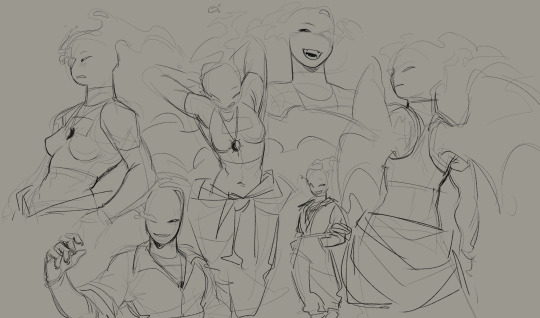
^ Ignis (He's a fallen angel, just like Haden! I'm strying trying to figure out her past design... But! This one isn't going to change I'm sure. Well. 80% sure, at least. They're also from Spes!)

^ Maru (Shes an alien Idol! Sadly I didn't do much on her story yet but she's half alien half human, since I (sadly......²) only have her concept on hand. I haven't decided which world she belongs to yet but I'm thinking on putting her alongside my other gay aliens for the funnies. Would be nice if she was a bit of the reason why Vector wanted to become a pilot. No I won't give context now)
ANd last but not least- minecraft ocs!!!


From left to right- Cain, the creeper is a vocalist/guitarrist without a band. Pete, the slime is a hunter (yes he hunts while serving cunt). Sulfur, the Warden is a farmer.
That's it- that's the post. Ty. I will share more blorbos later. Probably. I've been sick today and just wanted to get stuff for my ocs here :')
#pipposketchdump#oc art#ocs#my ocs#original charater art#Idk! What more to add in tags#Also about the game- I think I mentioned it here before? Idk#Don't remember that well#But the game would be named malfunction as of now#But again it has been put to sit#for a while#I want to try my hand on doing a smaller game#and well not start with my DREAM GAME#specially after how much ive put of myself into building stuff for malfunction#anyway.#uhm.#oc artwork#I'll divide the oc worlds into tags later!!!#since they're all together here I don't think it'd be cool to just put all the tags here#it doesn't itch my brain if I do that
46 notes
·
View notes
Note
I got excited just now seeing some of your mosquito-positive posts because I am currently on a deep dive about mosquitoes as well! same hat!
It will actually be pretty funny if I cultivate a reputation for myself as a pro-mosquito blog despite the sheer number of them I ruthlessly squish on a daily basis. I must admit I am not immune to becoming absolutely incandescent with rage at the mere sound of that telltale whine by my ear.
That said, I am very grateful that I am the type of person that can hold both irritation and curiosity towards an animal at the same time. I am a pro at smacking skeeters, but I still find them incredibly interesting, and I’m still able to understand the role that they play in all kinds of ecosystems.
There are so many mosquitoes that are completely incapable of harming humans but I still get so many furious people in my ask box whenever I say I think mosquitoes are important! The only way to effectively prevent vector-borne diseases in humans is to start with a thorough understanding of the animals that spread these illnesses. And sure, you and I trawling Wikipedia for information on an obscure mosquito species won’t cure Dengue fever, but maybe the two of us adding to the collective human understanding of these animals is objectively a good thing?
Anyways sorry for the rant but hell yes same hat 😅 🎩
108 notes
·
View notes
Text
TFP S.A.R.I. Time Skip
This is sort of an amalgam of Knowledge I have lf transformers, and it’s a bit loosey goosey so I might come back to this later and edit/rewrite it when I get caught up to MTMTE, and LL. Going off on sooome info I was told on certain bots like how Rung is a therapist and Megatron gets a redemption arc. I uhh also gotta finish season 3 of prime and watch the beast hunters movie. So we’re going off that and a bit of cyberverse here, skybound there, idw here and there whereever. Just gotta fit the vibe. It’s very informal for right now but it will be tightened up later as I get caught up with the comics and Prime TV Show.
This takes place 10 years after Prime so Sari would be 18 at the start of this iteration. And being a young adult/alien after being part of an intergalactic civil war is a nightmare with all the stuff you gotta unpack.
After the events of Prime, Sari attempted to go to human school, thinking she got her powers under control, she did not take into account people would go out of their way to bully her. Having lead to an incident where she defends herself but lead to a situation where some people got hurt and she decided to finish her education on Cybertron, feeling that if she was on Earth it might put others in danger.
Post Prime she is distraught over Optimus’s death. She very much picks up a grouch personality from Ratchet and gets very jaded. She has mandatory visits to Rung, and each appointment she is very avoidant or makes lite snarky jokes through them and is very aware of her problems. Though Rung gets her to stay the full session by offering her Earth snacks and she can only deal with the flavor of Sprite for so long. It wasn’t until a new leader was selected by the Matrix of leadership being Rodimus, that she actually discussed what happened.
In her time in Cybertron most times often than not, Sari would isolate herself and be a loner. And she would often try to hide the fact that she’s part organic, feeling that her first experience with school and not being diligent enough with her abilities caused people to get hurt, and she over corrects by isolating herself and thinking if she’s the best medic maybe she can reverse or mend the harm she caused or maybe she just does not want to be hurt again. Though Hot Rod would find Sari to be really interesting and actually wants to be her friend. And he’s actually quiet persistant.
The matrix of leadership chose Rodimus in the Sari AU, and it is because Hotrod reminded the matrix/the allspark/optimus’s soul of Sari and how kind and willing to be a friend to anyone no matter what. And Sari would warm up to Hot Rod, and get in touch with that side of herself again. And just Ratchet would be so happy that Sari is having fun again and being a dumb young person. They would have a Bumblebee/ TFA Sari Dynamic where they share the same brain cell or a sort of Brother/Sister Relationship.
When Sari is on Cybertron, she uses her alt form mostly and on rare occasions and privacy takes on her normal mode. Mainly to have people not think differently of her, and for Cybertronians not to recognize her. After the incident in High School she sort of exiles herself to Cybertron thinking to herself she does not belong with humans and completed her education with the high guard academy.
As a sort of an high guard academy graduation present for Sari maybe Jack and June make a necklace for Sari being a pendant that looks similar to the Key to Vector Sigma. As a sort of nod to her and Jack’s adventure when she was little and a thing to hold close to her when thinking about Optimus.
She is especially critical of Rodimus when he becomes a Prime because he reminds her of herself when she was younger and she hates how she was when she was that age despite being a child and in a very strange situation. And Rung calls her out on this saying “This new Prime…when you criticize him you use similar language to when you tell me about your years on team prime and criticize your younger self” and she is shocked and horrified at this revelation.
She would have alot of first and secondary trauma, and hold a lot of resentment to the reformed Megatron, to a point where she picks a fight with him ON SIGHT. Though this ends up being bridged over and they would talk to each other about Orion/Optimus. With Sari knowing about his Optimus days and Megatron on his days as Orion and she realizes “Holy crap YOU GUYS TOTALLY LIKED LIKED EACHOTHER”
Homegirl as soon as she would turn 18 would get a tattoo of the autobot insignia on her shoulder. Much to Ratchet’s shagrin.
Rodimus would learn what kind of person Sari was when she was on Team Prime when they visit June, and June gushes over Sari and is like “I get you are busy with your medibot studies but it doesn’t kill you to stop and visit??” And June goes out of her way to show pictures of Sari as a kid and even showed pictures of Sari in her Optimus costume, saying “She was such a Daddy’s girl when she was little. Always wanting to help out and make Optimus and Ratchet proud.”
Sari post timeskip had this reputation of being this straightlaced no nonsense medic, but then in secret have a secret career in a more tamed version of the cybertronian gladiator pits. Like wwe wrestling. And has like the alterego of Malpractice or something and saying “Just because I can put bots together doesn’t mean I can’t take them apart”. And like she would channel her younger self in the arena not being above biting and all. Putting on a damn Luchador mask.
Hot Rod would learn of this and use that as blackmail-essentially karma for Sari’s antics with Jack and Smokescreen as a kid
When Sari tells Jack about this-he cracks up laughing
And Megatron seeing the straight laced no nonsense Sari is just like “If you were to tell me that scraplet and this medibot were the same being I would have assumed it was another of Starscream’s games.” But then when Hotrod shows him her in the arena-he is like “NOW THAT IS THE SCRAPLET THAT WAS THE BANE TO THE DECEPTICONS”
I just imagine her going for the cybertronian equivelent of the achilles tendons and just biting and ripping them out like a feral animal
Essentially using her medical knowledge to pin point where to take bots down
And just Hot Rod/Rodimus being horrified and Megatron being impressed
I just imagining her screaming to the mic “THE DOCTOR IS IN, AND SHE IS PERSCRIBING 33 CCS OF GET FRAGGED.”
She’d probibly scream into the mic after she won saying “IM A VIRUS YOU CAN’T GET RID OF”
I could see her after beating a contender pulling up a pen and paper writing a perscription and it being written on it “COPE”
I could see her doing this after Rung suggest her getting an outlet for the pent up emotions she was feeling.
#maccadam#transformers#tfa sari#tfp optimus prime#tfp ratchet#tfp megatron#tfp au#megop#tfp megop#tf animated#tfa#archive of our own#tfa au#lost light#more than meets the eye#keep spoilers to a minimum
41 notes
·
View notes
Text
Resources on Prieur de la Côte-d'Or
I decided it was about time to compile a convenient list with all the information and resources I could find about Claude-Antoine Prieur, also known as Prieur de la Côte-d'Or.
It's very much a work in progress: some posts, those without a link, are yet to be written. The list will be updated and edited with time.
♢ Biographies
Full books
Paul Gaffarel - Prieur de la Côte-d'Or, Librairie Noury, Dijon (1900).
Georges Bouchard - Prieur de la Côte-d'Or, un organisateur de la victoire, Librairie Historique R. Claveruil, Paris (1946).
(Not only I plan to transcribe both of them in a lighter, more readable format, but also to write a post comparing the two, though this should wait until I finish reading them fully. For now, from what I could see, none of the two could be considered a definitive Prieur biography: Paul Gaffarel didn't have access to Prieur's personal papers, resulting in a very incomplete work and inaccuracies; as far as Bouchard is concerned, he was no historian but a chemist and it shows both in his very superficial interpretation of the historical period in which Prieur lived and in the uncritical way in which he analyses primary accounts and sources about the latter.
For anyone interested in Prieur's life, I would recommend you to start from the 1946 one: despite the many criticism I personally have towards it, it's more complete, since Bouchard was granted access to Claude-Antoine's papers.)
Summaries
Timeline for Prieur's life
"Profile card" by @saintjustitude.
Translation of Gainot's entry on Prieur mentioned in Dictionnaire des membres du Comité de Salut Public
♢ Primary Sources
Correspondence and personal writings
Prieur's letter to Louis XVI on the importance of having a unified metric system in France
Prieur's letter to Guyton dated 10 Thermidor an II (28 July 1794)
Prieur's speech of 3 Germinal an III
Prieur's last written letter (to Simonne Frilley)
C.A. Prieur - Révelations sur le Comité de Salut Public (I plan to translate them all into English eventually)
Modern transcription of Prieur's first work on the metric system: Mémoire sur la nécessité et les moyens de rendre uniformes, dans le royaume, toutes les mesures d’étendue et de pesanteur
PNG Vector of Prieur's signature (by @senechalum)
Some excerpts from Prieur's first work on the metric system: 1. On the benefit of using the decimal scale 2. Conclusion of the memoir (summary of Prieur’s proposal)
Prieur's speech on the occasion of his admission to Dijon's Academy of Science
CSP decrees written and/or signed by him
Copy of the Letter of the Committee of Public Safety to the Directory of the District of Valence dated 19 Pluviôse [Year II]
♢ Secondary Sources
Camille Richard - Le Comité de Salut Public et les fabrications de guerre sous la Terreur, Rieder Ed., Paris, (1922) (A very interesting book on the warfare during the Terror (93-94), explaining Prieur, Carnot and Lindet's duties and contributions.)
Bertrand Barère on Prieur
Paul Arbelet on Prieur
Paul Arbelet - La jeunesse de Prieur de la Côte-d'Or, Revue du dix-huitième siècle (1916)
Bulletin de la Sabix - n°8 (décembre 1991) (it's a small journal written in French with some articles about the founding of the Polytechnic School and Prieur's role in it)
♢ Posts & Miscellanea
General tag on my blog
Prieur's personality: an introduction by @saintjustitude
Various portraits
Quotes (by him and on him)
Prieur's baptism certificate
Prieur's family crest
On Prieur's family
On Prieur's daughter (some additions by @nesiacha)
On Prieur's disability
Charles Bossut on Prieur's school perfomance at the École de Mézières
On Carnot and Prieur’s friendship (1, 2, 3, 4)
Prieur was never named Compte de l'Empire by Napoléon
On the mutual dislike between Prieur and Bonaparte
Historical inaccuracies in Arte's documentary Un mètre pour mesurer le monde
Prieur's contributions to the establishment of a new unified metric system
How Prieur and Carnot were elected members of the Committee of Public safety
Prieur's duties and contributions as member of the CSP
Prieur's contributions in the foundation and political defense of the École Polytechnique
Prieur's attendance at the CSP
Prieur's depiction in media
The bizarre legend about Prieur knowing that Louis-Charles Capet was freed from the Temple and substituted with another child
#frev#frev sources#prieur de la cote d'or#claude antoine prieur#claude antoine prieur duvernois#prieur de la côte-d'or#prieur duvernois#the amount of times i've written the word “prieur” makes me look insane D:#<- but i'm sane!! believe me!
41 notes
·
View notes
Note
Are there ways to actually "program" cells to produce these proteins? Like if you fed ribosomes the right RNA sequence, would it synthesize a bullshit protein molecule that does nothing useful, or would it start falling apart immediately in reality? My knowledge on DNA splicing is old and I know near nothing about proteins so I'm just curious if it'd ever be possible to get a real world representation of anything on your blog (setting aside the cost and effort it would take to do that)
yes there is! and you actually got pretty close, but you have to go a bit further back and use DNA (there are ways of delivering RNA to cells, but I haven't done that personally, and for something like protein purification that would not be the method of choice, so I won't be going into that. there are two main ways of inserting coding DNA into cells: using a transient expression plasmid and gene editing. note: all of these will be very brief overviews, so if you want more detail about any part of this, then please ask!
first i'll go over the simpler method which is using plasmids. i've been doing a lot of molecular cloning lately specifically to put proteins into expression vectors so i can purify them and do some work with the pure protein, which is what i assume you would want to do here. (sidetone: once you have some purified protein, there are a number of different things you can do to find out its sequence or structure, but that is a whole other post). plasmids are circular bits of DNA outside of the genome that are not necessary for survival, but carry useful information. most of the ones used in labs will also have an antibiotic resistance gene or some other marker so we can select for only the cells with the plasmid by growing them in media with the right drug. using specific enzymes, we can cut these plasmids and then insert a new fragment of DNA coding for whatever we want, before sealing them back up. Then, a small amount of the plasmid can be transformed into cells (bacteria and yeast are commonly used), which will multiply and make more of your plasmid, as well as whatever it encodes if the conditions are right!
Genome editing is a broad topic, so i'm just going to give you a quick overview of CRISPR-Cas9, which I have a bit of experience with. this isn't something i would do if i just wanted to make a lot of a given protein, but it is useful to look at how much of a protein is made under the native expression system within a cell, or to edit the sequence of a protein being made (and much more...). Cas9 makes a cut in both strands of genomic DNA, but the really neat thing about this is that you can easily tell it specifically where to cut. to do this, you will build a plasmid with the gene for the Cas9 protein, as well as the guide RNA matching the sequence where you want the cut to be. there are other design considerations, but i'll save that for now. once the DNA has been cut, the cell starts to panic and try and stick it back together, but not before some random bases get added and/or deleted from either of the broken ends. this is useful if you want to knock out a gene, because you can go in and mess up its promoter or something similar so that it never gets made. if that is too messy and random, or if you want to knock something in instead of knocking it out, you can also take advantage of the cell's repair mechanisms. if a double stranded break happens, the cell would prefer to fix it properly, and so it will try and remake the DNA using the other matching chromosome as a template. but, if you add in another plasmid instead that contains sequences matching either side of the break with something you want to add in sandwiched in between them, you can make the DNA repair itself with your new sequence!
finally, all of this assumes that the protein would be successfully translated, and would not be so toxic to cells that anything expressing it dies. we would need to add a methionine (start) to the beginning of nearly all of these sequences, and ideally codon optimize them for the specific organism. ordering the custom DNA sequences also wouldn't be cheap, but is also not impossible. an inducible expression system would also help reduce the risk of toxicity and let us make a lot at once if we so desired. we would probably also want to add a tag to make these easier to purify if we wanted to use the protein itself.
again i am not great at being brief and i have no idea how much the average person knows about any of this, so please ask more if anything i've said needs clarification!
letter sequence in this ask matching protein-coding amino acids:
AretherewaystactallyprgramcellstprdcetheseprteinsLikeifyfedrismestherightRNAseqencewlditsynthesieallshitprteinmleclethatdesnthingseflrwlditstartfallingapartimmediatelyinrealityMyknwledgenDNAsplicingisldandIknwnearnthingatprteinssImstcrisifitdeverepssiletgetarealwrldrepresentatinfanythingnyrlgsettingasidethecstandeffrtitwldtaketdthat
protein guy analysis:
you know that feeling when you're writing a test and aren't really sure what the answer is, but you try and put down everything you know in the hopes of getting some part marks? i feel like that's what this protein looks like. there is an assortment of secondary structures all spread out between loops and even a beta sheet, as if AlphaFold was trying its best to make something out of this. still, it doesn't look the way we would expect from an ordered protein, and i do not trust it.
predicted protein structure:

#science#biochemistry#biology#chemistry#stem#proteins#protein structure#science side of tumblr#protein asks#protein info#cloning#CRISPR
41 notes
·
View notes
Text
THE BLOGGIES 2023: FINALISTS
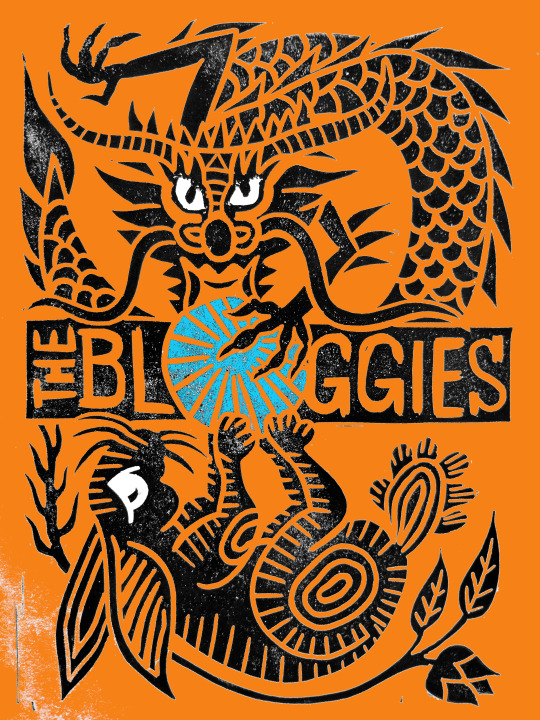
(If you just want to skip to the list of BLOGGIE finalists, scroll to the "Who Are The BLOGGIES?" section below.)
+++
WHAT ARE THE BLOGGIES?
Awards for some of the best tabletop roleplaying game (TTRPG) blog posts to come out in 2022. There will be five awards: Best Theory Blogpost, Best Gameable Blogpost, Best Advice Blogpost, Best Review Blogpost, and, the biggest one, Best Blogpost.
I won Best Blogpost, last year. So I am hosting the BLOGGIES, this year.
+++
WHY ARE THE BLOGGIES?
Blogs are worth celebrating. Barring the actual playing of actual games, they are our most fertile field, our most volatile laboratory. Longform, text-based, and informal---they are a place to jot down our most outre design ideas. Free and publicly available---they are a vector for open debate and serendipitous discourse. Perhaps most importantly: relatively free of algorithmic social-media pressures---they are the best chance we have at a cultural memory.
I got into TTRPGs because of blogs.
The BLOGGIES are, at best, an affirmation of the above. At least, they are a way to celebrate 64 excellent blog posts from the last year, and maybe get them in front of people who did not read them the first time.
+++
HOW ARE THE BLOGGIES?
Nominations: I put an open call for blog-post nominations on Christmas 2023; I also canvassed the TTRPG communities I am part of. Nominated posts had to be from between 1 December 2022 to 31 December 2023.
I closed the nomination period on 1 Jan 2024 with 149 blog posts for consideration. I read / re-read them all.
I chose a slate of 64 finalists, according to the following metrics, in order:
Enthusiasm---a post got multiple nominations;
Diversity---no one blog was allowed to be a finalist more than once in a category (except the Reviews category, where this rule was tied to individual writers, due to shared review blogs);
Notability---a post was extraordinary in presenting a novel idea, addressing an important subject, or reflecting a community current.
Obviously, that last metric is highly subjective, and limited to my knowledge and perspective in the scene. I did my best.
I will not have final final say. Finalists will go head to head, vying for to be anointed best of the best by ballot. The bracket was seeded in order of number of nominations received. The BLOGGIES await your vote, o TTRPG folx.
+++
WHEN ARE THE BLOGGIES?
Throughout January 2024! Voting is >>>NOW OPEN<<< on Google Forms according to the following schedule (I will link to the forms and result threads as I post them):
First Week January - THEORY
3 January: Round of 16
4 January: Round of 8
5 January: Round of 4
6 January: Quarterfinals (winners in category) - Results
Second Week January - GAMEABLE
10 January: Round of 16
11 January: Round of 8
12 January: Round of 4
13 January: Quarterfinals (winners in category) - Results
Third Week January - ADVICE
17 January: Round of 16
18 January: Round of 8
19 January: Round of 4
20 January: Quarterfinals (winners in category) - Results
Fourth Week January - REVIEW
24 January: Round of 16
25 January: Round of 8
26 January: Round of 4
27 January: Quarterfinals (winners in category) - Results
31 January - FINALS
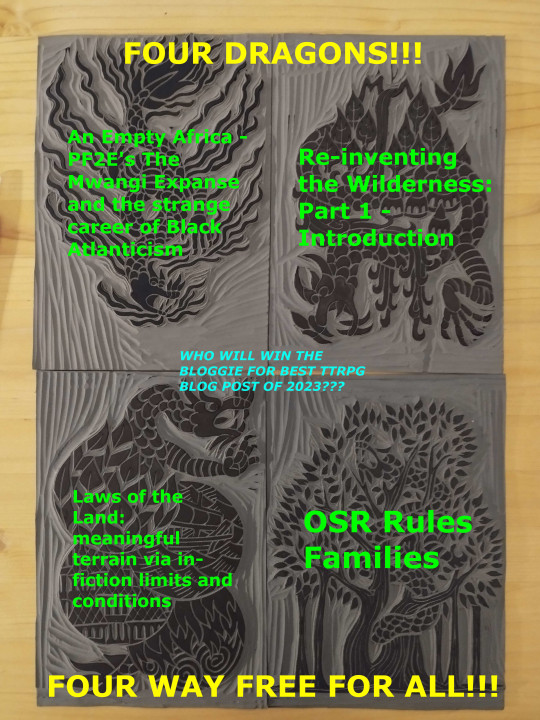
+++
WHO ARE THE BLOGGIES?
Your BLOGGIES 2023 FINALISTS are (presented in bracket order):
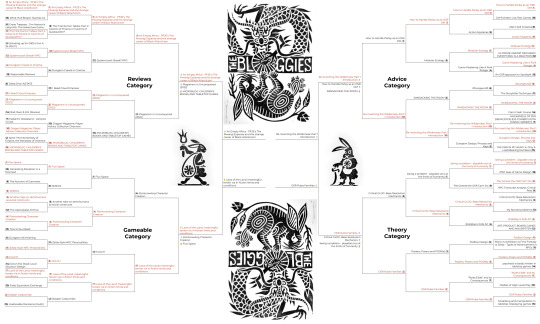
(High-res version here)
+++

THEORY
🥉 (1) being a problem - playable orcs at the limits of humanity, from Majestic Fly Whisk Some deep thinking about the racialisation of the orc in elfgames, why mainstream fixes fall short, and ways to move beyond.
vs
(16) #132: Axes of Game Design, from The Indie RPG Newsletter An exploration of the design axes / spectrums on which every TTRPG may fall.
(8) The Genres the OSR Can't Do, from A Knight At The Opera Sketching the limits of the OSR playstyle by looking at genres which are too differently-bound for it to emulate.
vs
(9) RPG Transcript Analysis: Critical Role, from Trilemma Adventures Examining a style of play through transcript analysis (looking at what is actually being said during a session), with Critical Role as case study.
🥈 (5) Critical GLOG: Base Resolution Mechanics, from Goblin Punch A deep dive into dice and resolution mechanics, and what they do in practice.
vs
(12) My favorite problems, from Failure Tolerated A list of design problems in TTRPGs, and a case for game design and theory to be driven by problem-solving.
(4) Roleplay Is Folk Art, from Wizard Thief Fighter An impassioned call to consider TTRPGs as folk art as opposed to corpocratic walled-garden IPs.
vs
(13) ART, PRODUCT, BOARD GAMES AND MAUSRITTER, from Fail Forward Critique of reviews that accuse TTRPGs for being too slick; interrogating the assumptions behind the label “commercial”.
(6) Toolbox Design, from The Dododecahedron Considering the principles of designing TTRPGs like toolboxes, through the lens of Cairn RPG and similar.
vs
(11) Mario vs ActRaiser vs Final Fantasy vs Zelda - Types of Advancement in RPGs, from Rise Up Comus Identifying some general types of advancement in TTRPGs, using videogames as a comparative lens.
(3) Posters, Posers and POSR(s), from Prismatic Wasteland Relitigating whether the OSR is dead, and defining its successor, the Post-OSR.
vs
(14) psychosis is badly written in tabletop games, from paper cult “Attempting to mechanize something so intensely personal, different, and mutable as mental illness is complicated. I think that makes these depictions bad!”
(7) “Rules Elide” and Its Consequences, from Jared Considering the implications of the maxim that "a game is about X when you have rules for everything but X".
vs
(10) Models of High-Level Play, from Benign Brown Beast Loose but useful classifications for types of high-level play: domains; god-like play; etc.
🥇 (2) OSR Rules Families, from Traverse Fantasy Sketching the landscape of the OSR, how various systems function, and how their attributes cluster and trend together.
vs
(15) Moralising and manipulation in tabletop roleplaying games, from Playful Void The importance of having design preferences without tying these preferences to moral judgments.
+++

GAMEABLE
🥉 (1) Flux Space, from Papers & Pencils A point-crawl procedure specifically designed for labyrinths / dungeons that are architecturally confusing / samey.
vs
(16) Generating Elevation in a Hexcrawl, from Traveler's Rest Procedures and advice on how to generate a mountain-crawl: hiking-focused adventure geography.
(8) The Autumn of Summers, from False Machine God-monsters born of summer, the hunting culture around such beasts, and random tables to generate their attributes.
vs
(9) MIMICS, from Vaults Of Vaarn A spread of novel pretender-creatures, with ecological and social implications.
(5) Another take on demihumans as social constructs, from Cavegirl's Game Stuff What if we consider fantasy races not as separate species, but as differing social roles?
vs
(12) The Apocalypse Archive, from Bearded Devil An unfinished by exemplary #dungeon23 attempt that includes wonderful maps and soundtrack notes.
🥈 (4) Pointcrawling Character Creation, from Rise Up Comus A framework for tying character generation to a geography, generating history and familiarity with campaign locales.
vs
(13) how to be erased, from Straits Of Anian Procedures for getting lost and getting led astray, and the kith and spirits one meets in those places.
(6) Dungeon Skirmishing, from All Dead Generations Feature-complete skirmish combat mechanics for OD&D, and the design rationales thereof.
vs
(11) Zelda-Style NPC Personalities, from To Distant Lands A system of generating quick and punchy NPCs, inspired by the way Zelda videogames present NPCs.
(3) GULCH, from Mindstorm A starter town specifically designed for contemporary (horror, urban fantasy, non-fantasy) campaigns.
vs
(14) Down the Road: Local Situation Design, from Deeper In The Game A procedure for quickly generating a powderkeg situation in a local geography of play.
🥇 (7) Laws of the Land: meaningful terrain via in-fiction limits and conditions, from Was It Likely? A method to generate meaningful diegetic terrain and tone in an adventuring region.
vs
(10) False Equivalent Exchange, from The Graverobber's Guide A novel magic system, done in natural language, with discussion on how it could be used in play.
(2) Deeper Catacombs, from Benign Brown Beast Iteration notes and a presentation of a comprehensive dungeon tracking procedure.
vs
(15) Inadvisable Decisions (GLΔG), from The Nothic's Eye An evocative alienist character class, based on drawing the attention of alter-describable things from beyond.
+++

ADVICE
🥈 (1) How to Handle Parley as an OSR DM, from Goblin Punch Comprehensive notes on how to run non-combat encounters without resorting to boring rolls.
vs
(16) GM Pointers: Live-Text Games, from Shadow & Fae Good reminders on how to run live-text games better, so they are better coordinated and don't take forever.
(8) ONLY Roll Initiative, from Bastionland Considerations on how to adjudicate combats, if initiative were the only dice roll in a combat system.
vs
(9) Action Mysteries, from A Knight At The Opera Asserting that good TTRPGs mysteries involve action---not just figuring out the truth but opposing the antagonist's goals.
(5) Modular Ecology, from The Graverobber's Guide A practical approach to including gameable ecology in TTRPGs, by tying materials to specific locations and conditions of the world.
vs
(12) ULTIMATE ANIMIST MECHANIC: EVERYTHING IS A REACTION, from Alone In The Labyrinth How to run a game where all actions are resolved by reaction roll: everything in the world responds by how much they like you.
(4) Game Mastering Like A Park Ranger, from SILVERARM Advice about GM-ing, based on the real-world work experience of being a park ranger.
vs
(13) An OSR approach to Spotlight, from Permanent Cranial Damage The suggestion that intentionally spotlighting characters solves the real-life problem of spotlighting players nicely.
(6) #Dungeon23, from Win Conditions The idea that spawned a thousand notebook dungeons, plus salient advice on how to start / keep going.
vs
(11) The Storyteller Technique, from Possum Creek Games When writing TTRPGs, imagine your game text as a diegetic artefact in the world of the game.
🥉 (3) RANSACKING THE ROOM, from Mindstorm A simple and powerful three-step method to handle room-searching in games: inspect, search, and ransack.
vs
(14) Cairn Crash Course, from Widdershins Wanderings A masterclass example on how to write player guides to a game, for Cairn RPG.
(7) AN EXAMPLE OF FKR (NEAR-)DICELESS COMBAT (WITH COSMIC ORRERY!), from Underground Adventures Describing combat in a Free Kriegsspiel Roleplaying (FKR) game, useful in understanding that playstyle.
vs
🥇 (10) Re-inventing the Wilderness: Part 1 - Introduction, from sachagoat Figuring out problems with wilderness exploration, and applying a mental-map framework from urban-theory academia.
(2) Dungeon Design, Process and Keys, from All Dead Generations A detailed process to designing and keying a traditional dungeon adventure.
vs
(15) THE D&D IN MY HEAD: In Only 6 Load-Bearing Numbers, from I Cast Light! Identifying the essential and minimum rules you need to remember, to run D&D.
+++

REVIEW
🥇 (1) An Empty Africa - PF2E's The Mwangi Expanse and the strange career of Black Atlanticism, from Majestic Fly Whisk A review of Pathfinder’s "The Mwangi Expanse", and a discussion of Black Atlanticism's fraught relationship with its sourcelands.
vs
(16) What Hull Breach Teaches Us, from Mazirian's Garden An assessment of the Mothership RPG third-party "Hull Breach" anthology as a "new standard for anthology companions".
(8) Grave Trespass - Jim Henson's Labyrinth: The Adventure Game, from Bones Of Contention A review of the Labyrinth RPG. It’s got all these things which are "bad" in RPGs, so why does it work?
vs
(9) The First Rumor Tables, Part 2: Caverns of Thracia or Caverns of Quasqueton?, from Tom Van Winkle's Return To Gaming An investigation into the origins of rumour tables in TTRPGs. Did TSR plagiarise Jaquays?
(5) Standing up for D&D's Gen X: 2e (Part 1), from Mythlands Of Erce A full-throated defense of D&D2E, viewing it in the context of its time and as a refinement over 1E.
vs
(12) Systemcrawl: Break!! RPG, from Widdershins Wanderings A review and system analysis of Break!! RPG, which marries JRPG and OSR inspirations.
(4) Dungeon Crawls in Cinema, from Directsun Games Evaluating several films on the basis of how well they function as dungeon crawls.
vs
(13) Reasonable Reviews, from Rise Up Comus A general overview of TTRPG reviews, and what may or may not make them useful.
(6) Deep Dive: A|STATE, from The Indie Game Reading Club A review of a|state, and how it builds on and departs from the Blades In The Dark formula.
vs
(11) I Read Cloud Empress, from Playful Void A review of Cloud Empress, the first descendant of the Mothership RPG ruleset.
🥈 (3) Plagiarism in Unconquered (2022), from Traverse Fantasy A forensic analysis of how Unconquered plagiarised Ultraviolet Grasslands and Vaults Of Vaarn.
vs
(14) Rod, Reel, & Fist (Review), from Benign Brown Beast A substantial review of Rod, Reel, & Fist, a "system-forward fishing simulation RPG".
(7) Pedantic Wasteland - Vampire Cruise, from Bones Of Contention A review of Vampire Cruise, a largely system-neutral horror-comedy adventure set at sea.
vs
(10) Dragon Magazine: Player Advice Collection Overview, from Attronarch Athenaeum A comprehensive read-through and rating of 143 Dragon Magazine advice articles.
(2) Spire: The Monstrosity of Empire, the Necessity of Violence, from A A Voigt A comparative-literature analysis of Spire RPG through R F Kuang’s spec-fic novel "Babel, or the Necessity of Violence".
vs
🥉 (15) MICROBLOG: CHILDREN'S BOOKS AND TABLETOP GAMES, from Fail Forward Considering the influence of children’s books on TTRPG designers and works like "Barkeep on the Borderlands".
+++
It is difficult to describe how hard it was for me to whittle down the list of nominees to these finalists. I consider each of these 64 a landmark in 2023's TTRPG thinkings, and the folks from which they issue essential reading, going forward. They already deserve a prize.
So here it is, dear bloggers: a hand-carved linocut "finalist's pin" graphic you are free to use on your sites / posts, should you wish:
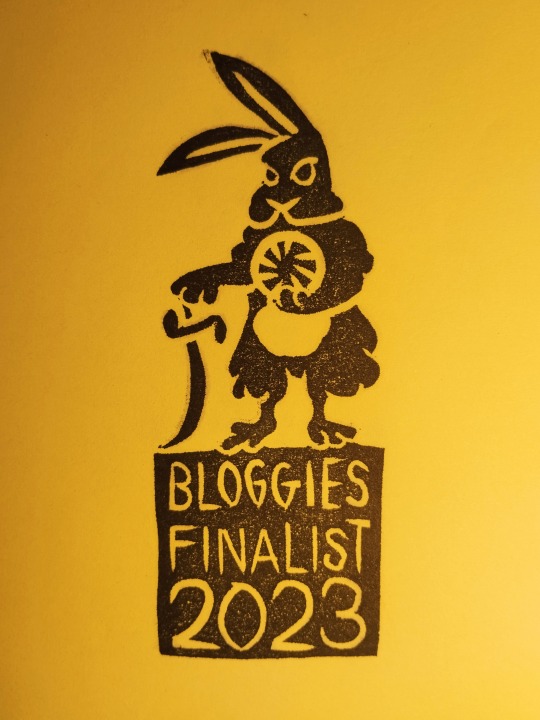
(High-res downloadable version HERE)
Thank you for writing! And good luck in the coming rounds of voting!
+++
CORRECTION: A blog post from 2021 (Not All Crunch Is the Same, from A Knight At The Opera), was included in the soft-launch posting of this list. An error on the part of its nominator, compounded by a data-entry error on my part. It has since been replaced by a post from the same blog with the actual most nominations (The Genres the OSR Can't Do). I have also double-checked my lists and all finalists. Apologies for my error!
182 notes
·
View notes